Are you eager to keep your garden lively and colorful even as the summer starts winding down? Late-blooming perennial flowers that peak in August could be your solution. Unlike annuals, which you have to replant each year, perennials come back season after season.
In August, when many other flowers have already made their grand exit, these late bloomers take center stage, filling your outdoor space with lively colors and lovely fragrances. In this article, we will discover some standout perennials that can make your garden a showstopper right through the end of summer.
1. Sunset Hyssop (Agastache rupestris)

One of the best perennial flowers that peak in August is sunset hyssop.
©Alex Manders/Shutterstock.com
Sunset hyssop is a sturdy perennial plant that sports spikes of salmon-orange blossoms framed by purple accents from July through September. These striking flowers rise above a bed of slender, silver-green leaves, adding both color and a unique spiky shape to your garden. This particular hyssop has a bloom peak in August, extending its colorful display well into the fall season.
Growing this plant is easy. It prefers full sunlight and soil that’s neither too wet nor too dry. While the plant can tolerate dry conditions, you may need to water it if there’s a prolonged period of drought. Make sure the soil drains well, as the plant doesn’t do well in soggy environments.
2. Texas Hummingbird Mint (Agastache cana)
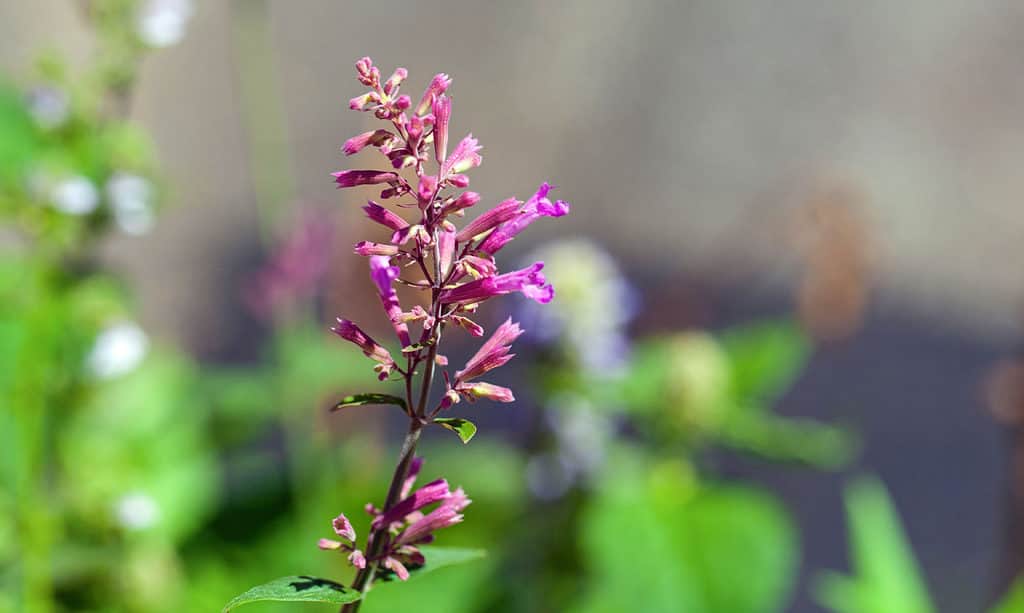
This is a sturdy perennial that flowers in August.
©ChWeiss/Shutterstock.com
Texas hummingbird mint is a sturdy perennial that grows tall and bushy. It showcases eye-catching spikes of rosy-pink, fragrant flowers from the start of summer until early fall. These vertical floral displays are not just beautiful; they also attract a variety of pollinators like bees, butterflies, and hummingbirds. This plant continues to flower profusely in August and maintains its beauty into the early fall months.
For optimal growth, place the plant in a spot that receives plenty of sunlight. It’s not fussy about soil and can tolerate a range from dry to moderately moist as long as it drains well. The plant is also resilient against light shade, drought conditions, and poor soil, as well as summer heat and humidity.
3. Climbing Aster (Ampelaster carolinianus)
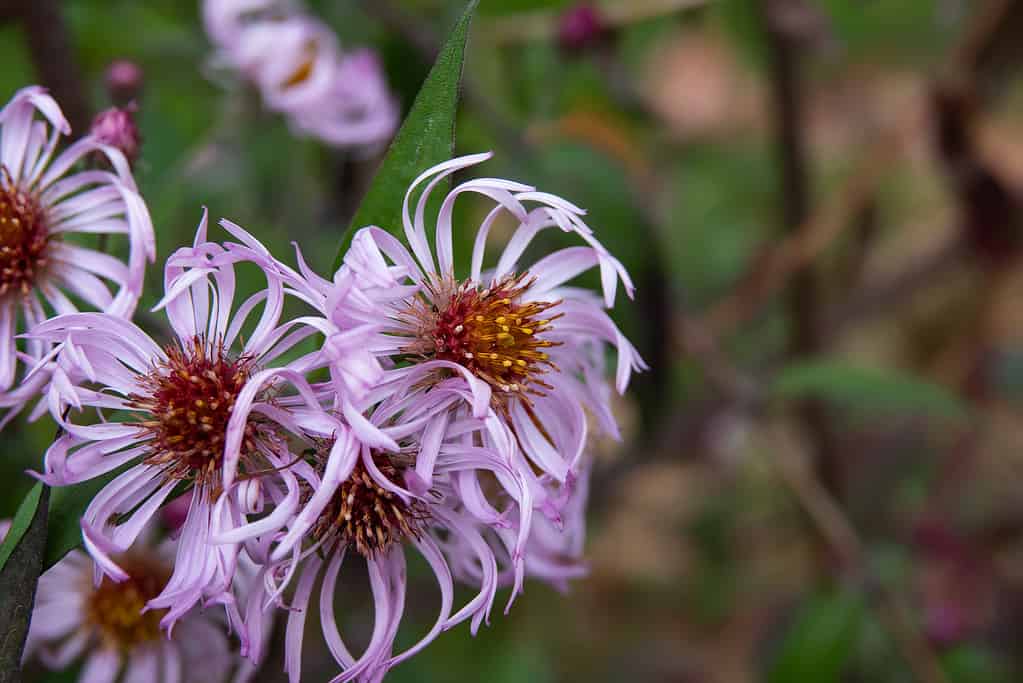
Blooming until the first frost, climbing aster peaks in August.
©ErikAgar/iStock via Getty Images
Climbing aster is a deciduous perennial that climbs and produces an abundance of eye-catching, daisy-shaped blooms. The flowers, measuring between 1 to 3 inches across, feature soft shades of lavender or pink that frame a bright yellow center. This flower begins its show in late summer and continues to dazzle until the first frost. These blossoms sprout from slender, woody stems adorned with narrow, dark green leaves. Originally from the southeastern U.S., climbing aster is a standout choice for adding late-season flair to your garden.
For the best growth results, plant it in a spot that gets a mix of full sun and partial shade. The soil should be moderately moist but well-draining. This resilient plant can even handle temporary flooding. Ensure the area has good air movement to help prevent leaf diseases like powdery mildew.
4. American Angelica (Angelica atropurpurea)
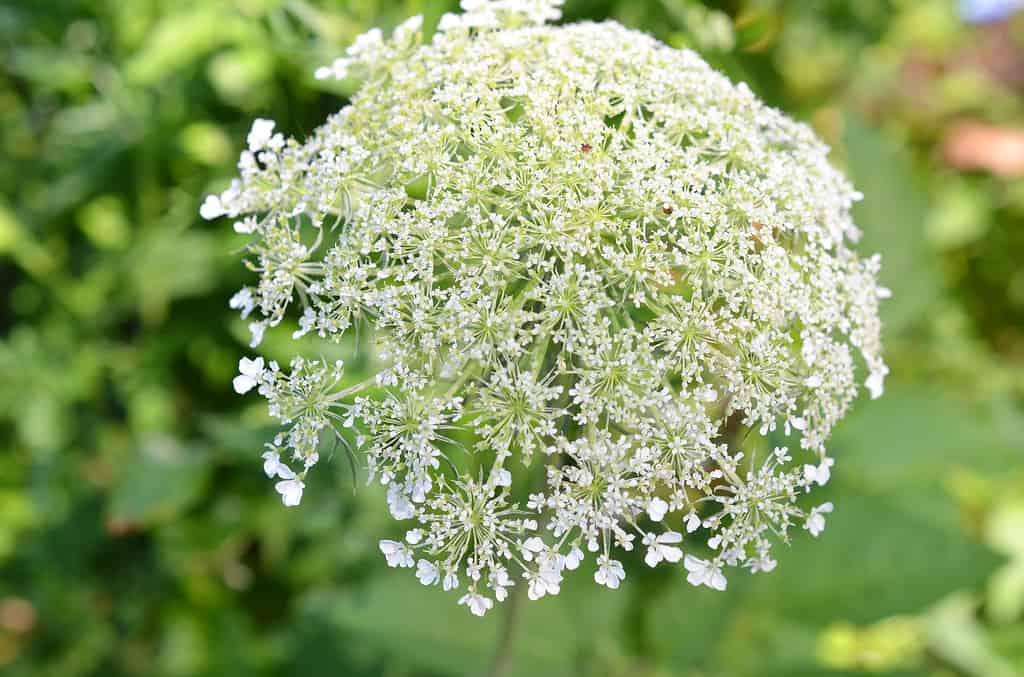
Boasting clusters of tiny flowers, American Angelica is a perennial herb.
©hongquang09/iStock via Getty Images
American Angelica is a sizable perennial herb that displays beautiful clusters of small, cream-to-green flowers. These clusters can be as wide as 4-10 inches and appear from the start of summer until early fall. These floral clusters sit atop smooth, dark purple stems that are hollow inside. Originally from the central and eastern regions of North America, this plant brings a distinctive look to gardens, especially later in the season.
Place American Angelica in a location that gets a balance of full sunlight and partial shade. It prefers consistently damp or wet soil and does exceptionally well in the cooler, shadier areas of the garden. This plant is even capable of tolerating standing water, making it versatile for different garden conditions.
5. Golden Columbine (Aquilegia chrysantha)

A beautiful perennial that peaks in August is the golden columbine.
©Kristine Rad/Shutterstock.com
Golden columbine is a hardy perennial that forms lush clusters and features striking golden-yellow flowers. These flowers can span up to 3 inches and come with extended, graceful spurs as well as a center filled with yellow anthers. Unlike some other varieties, these flowers stand upright on lengthy stems above a dense bed of fern-like emerald green leaves. The plant enjoys a lengthy blooming season. It peaks anywhere from late spring to late summer, including August and, at a push, September too! Native to the southwestern U.S., this plant is ideal for adding a splash of color to shady garden corners. It also looks stunning when spilling over rocks or walls.
For optimal growth, plant golden columbine in areas with light to moderate shade and soil that is fertile, moist, but well-draining. Although it can handle heat and a fair amount of direct sunlight, too much sun exposure can stress the plant and cause the leaves to lose their vibrant color.
6. Apache Beggarticks (Bidens ferulifolia)

Plant Apache beggarticks somewhere sunny.
©Tessa57/iStock via Getty Images
Apache beggarticks is a hardy, low-lying evergreen perennial that’s easy to care for. It dazzles with its abundant, mildly scented, bright yellow daisy-like flowers that can grow up to 2 inches wide. These charming five-petaled flowers bloom from the early summer months well into the fall. And in areas without frost, it can bloom almost all year long. The Apache beggarticks plant is notably resilient, thriving in conditions that include heat, wind, and even short periods of drought.
Plant Apache beggarticks in a sunny spot where the soil is dry to moderately moist and drains well. While the plant can manage dry conditions, it benefits from occasional watering during particularly hot periods.
7. Bay Bean (Canavalia rosea)
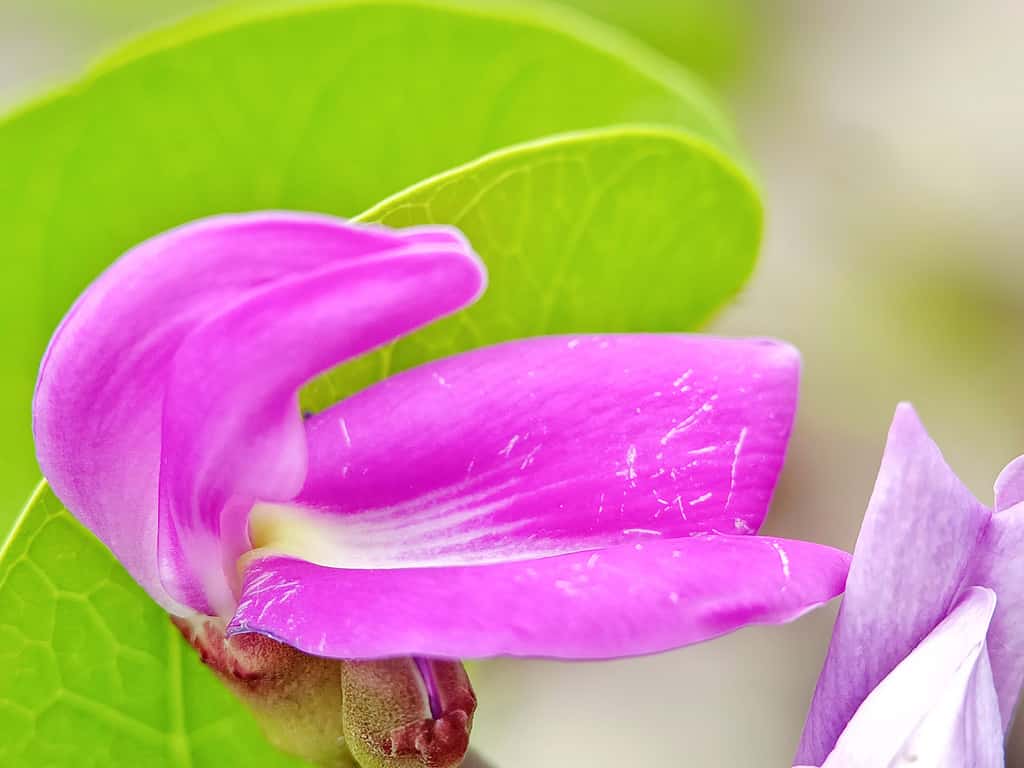
A perennial vine, the bay bean produces flowers that peak in August.
©ANIDA ARIPIN/iStock via Getty Images
Bay bean is a sprawling evergreen vine known for its vibrant green leaves and eye-catching clusters of pink to purple flowers. These blooms feature white centers that naturally guide insects, especially bees, to their nectar. While the plant flowers all year round, it is most prolific from summer to fall.
This hardy vine is native to various subtropical and tropical regions around the globe, from the Americas and West Indies to Australia, Asia, Africa, and the Pacific Islands.
Bay bean prefers full sunlight and soil that ranges from moderately moist to dry and sandy. The plant is quite resilient, handling both drought and salty winds with ease.
8. Pink Turtlehead (Chelone lyonii)
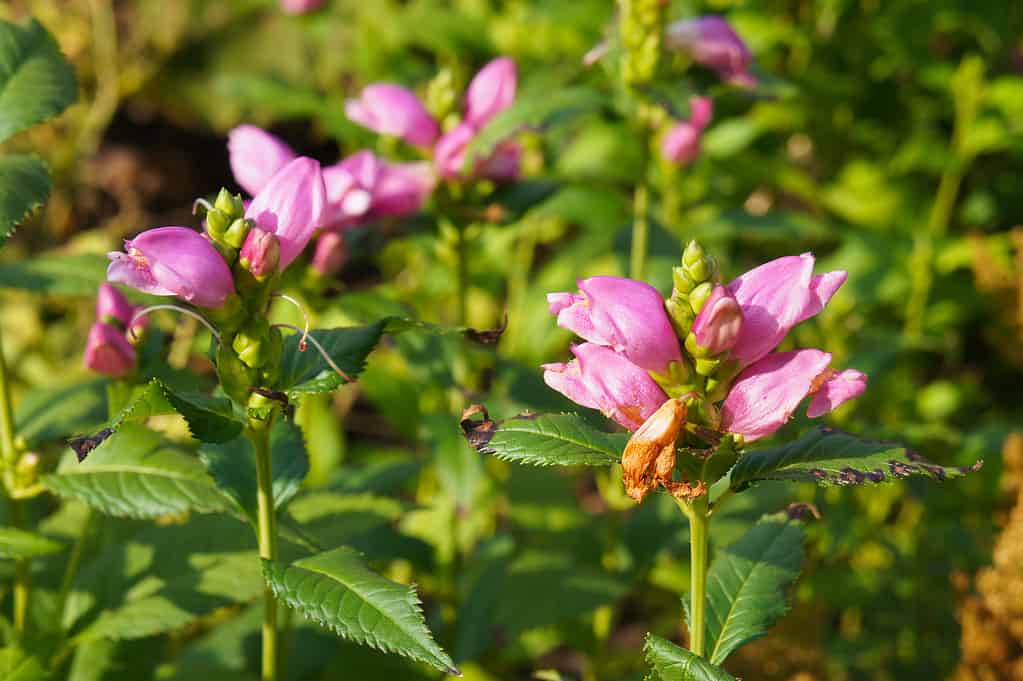
Boasting pink to purple flowers, the pink turtlehead looks like a turtle’s head.
©skymoon13/iStock via Getty Images
Pink turtlehead is a perennial that bursts into bloom with numerous spikes of unique two-lipped, pink to rose-purple flowers from late summer through fall. The blooms resemble the heads of turtles peeking out from their shells, which is how the plant got its common name. As a native to the U.S., this plant is not only eye-catching but also easy to care for and resistant to diseases and pests.
For optimal growth, pink turtlehead thrives in fertile soil that ranges from medium to wet and can be planted in locations from full sun to partial shade. While it can tolerate some deeper shade and wetter soils, it generally prefers just a bit of shade.
9. Queen’s Cup (Clintonia uniflora)
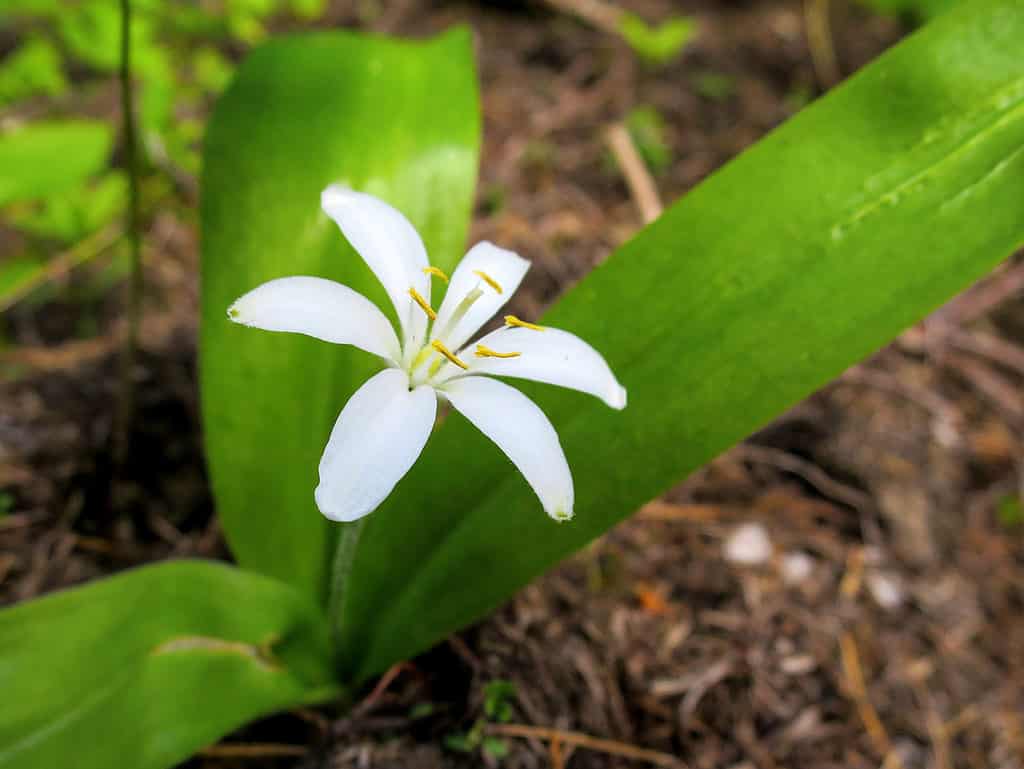
A perennial flower, the queen’s cup may bloom all the way to August.
©iStock.com/randimal
Queen’s cup is a captivating woodland perennial that creates a base of 2-3 shiny, fleshy, elongated green leaves, which can grow up to 6 inches in length. During the late spring to mid-summer months (usually May to July, but August, too, at a push), a stem without leaves shoots up above this leafy base, showcasing one or two white, star-shaped flowers with vibrant yellow centers. Native to North America, this plant is a long-living species capable of thriving for three decades or more.
For the best results, plant the queen’s cup in a shady area with soil that’s rich in organic matter and stays consistently moist yet well-draining.
10. Slender Dayflower (Commelina erecta)
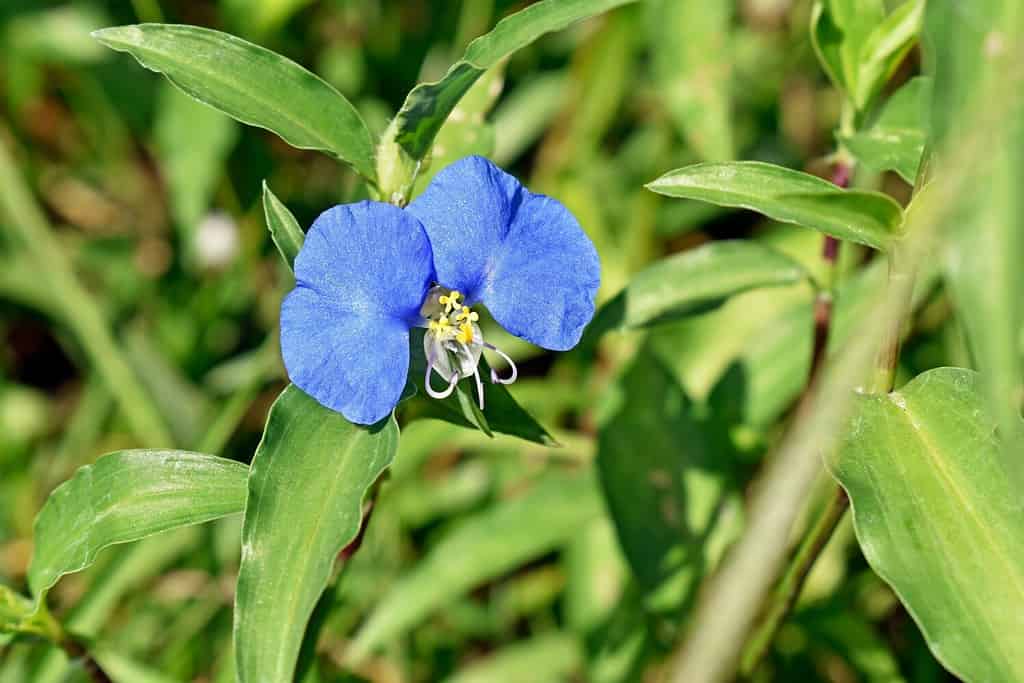
Another perennial flower that peaks in August is the slender dayflower.
©Wagner Campelo/Shutterstock.com
The slender dayflower is a robust perennial that features upright, often branched stems covered in bright green, lance-shaped leaves that can grow between 2 to 6 inches long. From late spring through fall, the plant bursts into bloom for roughly two months, showcasing small clusters of vivid blue flowers. Each flower consists of two large blue petals that look like ears, a smaller white petal, and stamens with yellow tips. What sets this plant apart is the unique true blue shade of its upper petals, a color rarely seen in wildflowers.
To ensure optimal growth, plant the slender dayflower in fertile soil that’s either sandy or rocky and well-draining. It prefers a location with full sun to partial shade and is also capable of tolerating drought conditions.
11. Blue Mistflower (Conoclinium coelestinum)
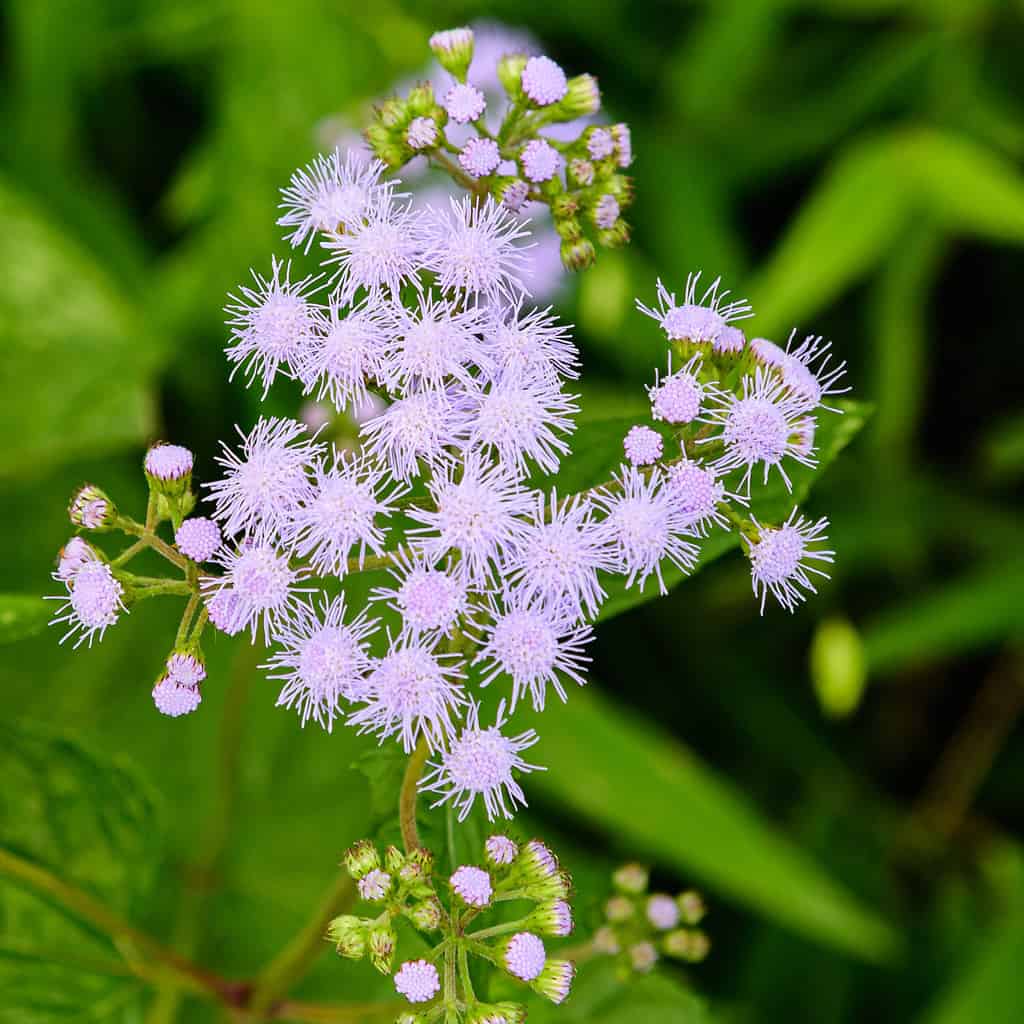
Blooming to late fall, the blue mistflower is a magnet for pollinators.
©Bill Bass Photography/Shutterstock.com
Blue mistflower is a perennial plant with a vertical, expansive growth habit. It produces numerous small, puff-like blue or violet blooms that appear in flat groupings from midsummer to late fall. These flowers, resembling the blooms of the ageratum, grow on purple-tinted stems and are a magnet for both bees and butterflies.
While the plant adds a burst of color to gardens, especially when other plants are losing their color, it’s worth noting that blue mistflower can spread quickly and might become invasive.
For healthy growth, it’s best to plant blue mistflower in soil that is both moist and rich in organic matter, with good drainage. The plant does well in locations ranging from full sunlight to partial shade and is also fine with wetter soil conditions.
12. Rock Harlequin (Corydalis sempervirens)
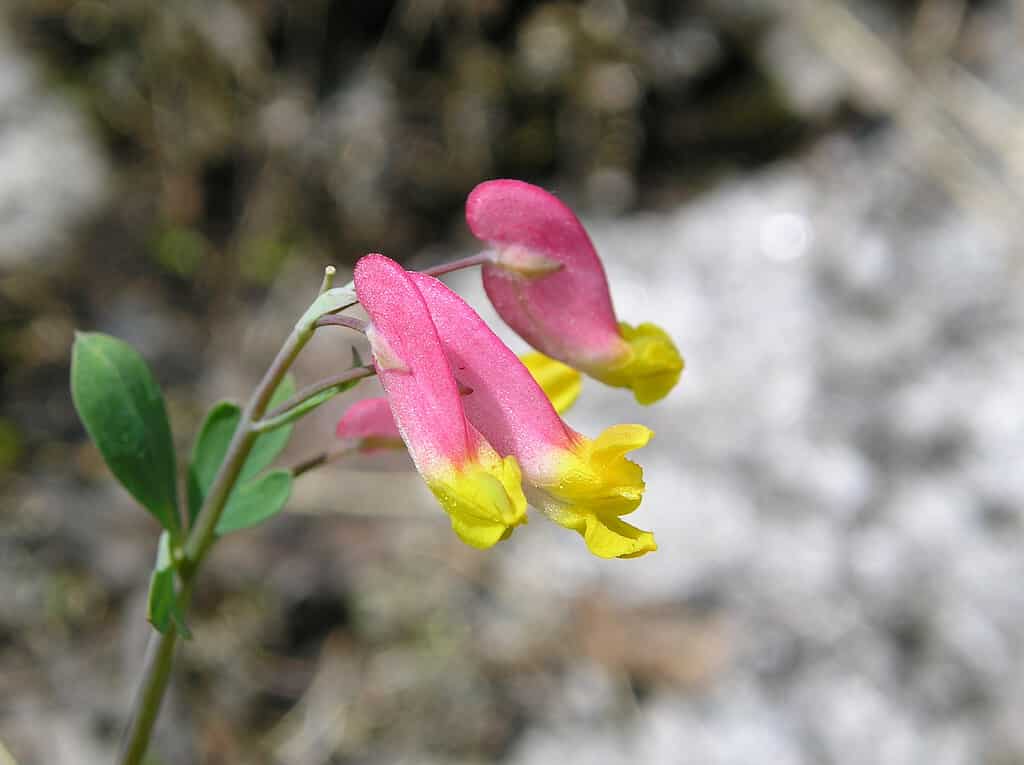
The blooms of the rock harlequin appear on and off from spring to fall.
Rock harlequin is a perennial plant native to the United States that features a rosette of blue-green leaves resembling ferns in its first year. Even without flowers, the foliage itself is striking. In its second growing season, the plant produces numerous branching stems, each crowned with hanging clusters of light pink, tube-shaped flowers that have yellow tips and measure about an inch long. These blossoms appear off and on from late spring through fall.
This plant is low-maintenance and does particularly well in regions with chilly winters and cool summers.
For best results, plant rock harlequin in a spot that gets either full sun or partial shade. It prefers dry, acidic, and well-draining soil, and it can even thrive in less-than-ideal conditions like poor, dry, or gravelly soil.
13. Yellow Coneflower (Echinacea paradoxa)

The yellow coneflower is a perennial flower that peaks in August.
©Wanda Ann Solomon/Shutterstock.com
Echinacea paradoxa stands out from its purple-flowered counterparts as it sports large yellow daisy-like blossoms. These flowers have drooping golden-yellow petals that encircle a dark brown, cone-shaped center. This coneflower variety is known for its hardiness and long-lasting flowers that bloom from the summer into early fall.
For optimal growth, place the plant in an area with full sun exposure. It does well in average soil that is neither too wet nor too dry. Be cautious about planting it in overly fertile soil, as it may cause the plant to grow too tall and become unstable.
14. Sulphur Buckwheat (Eriogonum umbellatum)

The yellow flowers of the sulphur buckwheat stay into the fall season.
©Geartooth Productions/Shutterstock.com
Sulphur buckwheat is a mostly evergreen perennial that adds a pop of color to gardens that get a lot of sun and have dry conditions. Its leaves take on a red hue as fall approaches, making it a plant that catches the eye for multiple seasons. Starting from red-tinted buds, yellow flowers emerge and stick around from the early part of the summer right into the fall season.
Originally found in the dry, rocky areas of southwestern North America, such as mountain ranges and foothills, this plant is a native favorite.
It grows best when placed in full sunlight and in soil that drains well. A little bit of watering during the summer months is all it needs, and it’s highly tolerant of tough conditions like drought and heat.
15. Queen of the Prairie (Filipendula rubra)
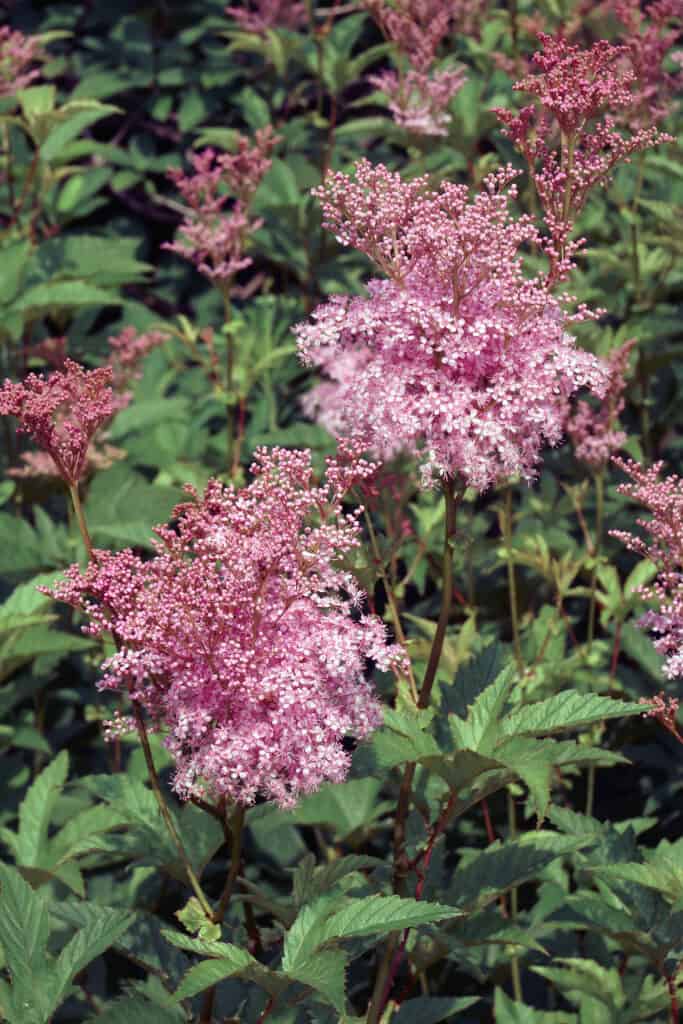
This is a perennial that boasts pink flower clusters.
©iStock.com/nickkurzenko
Queen of the prairie is an impressive perennial that stands tall and offers sweet-smelling pink flower clusters from the beginning to the end of summer, generally from June to August. These soft plumes sit atop leafy stems and are set off beautifully by the plant’s large, intricate green leaves. Originally from the U.S., this robust plant is appreciated not just for its blooms but also for its decorative foliage.
For optimal growth, this plant likes a mix of sun and partial shade along with soil that’s rich in organic matter and retains moisture. It doesn’t do well in dry conditions, so make sure to keep the soil consistently damp.
16. Indian Blanket (Gaillardia pulchella)
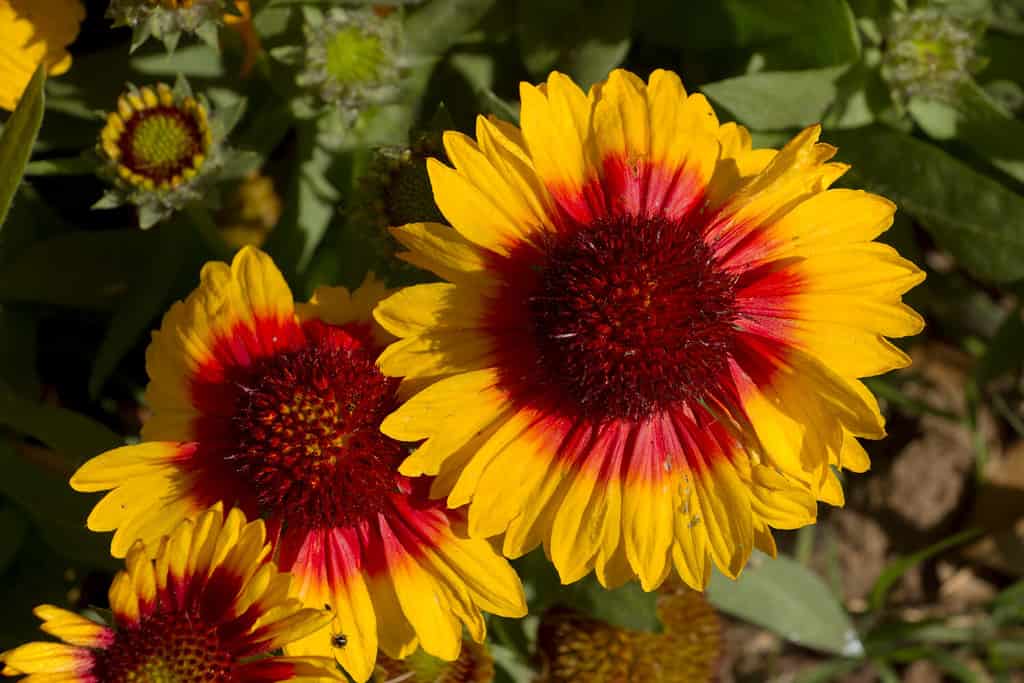
Indian blanket is native to the U.S.
©Nick Greaves/Shutterstock.com
Native to most parts of the U.S., the Indian blanket is an eye-catching flower that’s either an annual or a short-lived perennial. Its blooms resemble small daisies, measuring about 2 inches in diameter, featuring a reddish-brown center encircled by red and yellow-tipped petals. These flowers add a splash of color to gardens and pots from late spring until fall.
The plant is self-seeding and has the ability to spread quickly, forming tight clusters. In warm coastal locations, it tends to be a short-lived perennial.
This plant loves sunny locations and thrives in average, medium to dry soil that drains well. While it prefers sandy soil, it’s also fine with less fertile, dry soil. Soil that’s too rich will result in big, sprawling plants that have fewer blooms.
17. Great Valley Gumweed (Grindelia camporum)
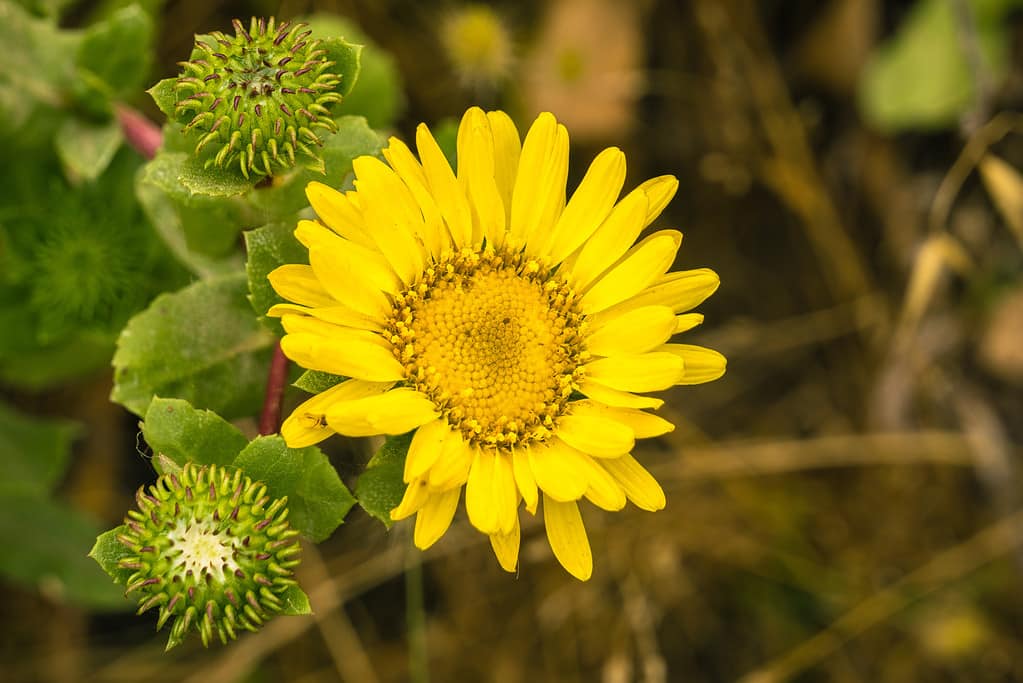
The Great Valley gumweed is a perennial flower that peaks in August.
©Sundry Photography/iStock via Getty Images
Originally from California and Baja California, the Great Valley gumweed is a perennial plant with semi-woody characteristics. It has a long blooming season that lasts from the end of spring through late fall, showcasing vibrant yellow flowers that resemble daisies. These flowers are about 2 inches wide and consist of 25 to 39 yellow petals surrounding a matching yellow center.
This plant is perfect for sunny spots and does well in soil that drains easily. It’s also notably resilient, capable of withstanding both dry conditions and salt.
18. Maximilian Sunflower (Helianthus maximiliani)
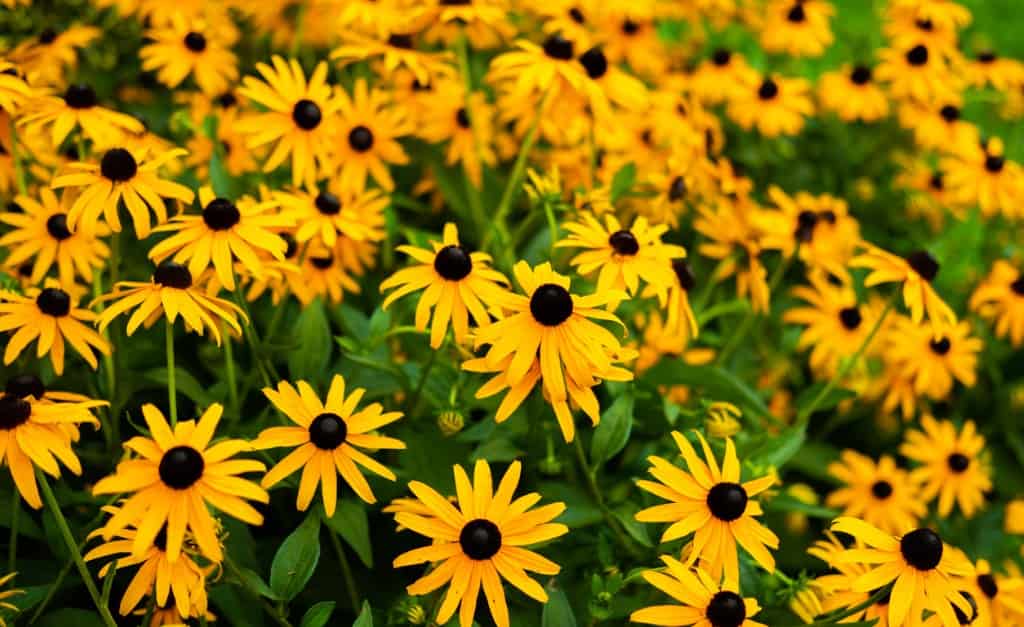
Make sure you have a lot of space for your Maximilian sunflower to grow.
©iStock.com/Steven Tsang
The Maximilian sunflower is a striking, tall perennial that’s hard to miss. Its stems are sturdy and covered with hair, while its elongated, gray-green leaves are also hairy and usually fold along their length. Bright yellow flowers, measuring 2-3 inches across, burst into bloom from late summer through fall, typically over a six-week timeframe. Each of these radiant blossoms features between 15 and 19 yellow petals encircling a darker yellow center. Given its size and spreading nature, this plant isn’t a good fit for small flower beds; it needs space to grow.
When it comes to sunlight and soil, this flower is pretty low-maintenance. It’s happiest in sunny locations and adaptable to a variety of soil conditions, ranging from dry to medium. Moreover, it can withstand periods of drought.
19. Scarlet Rose Mallow (Hibiscus coccineus)
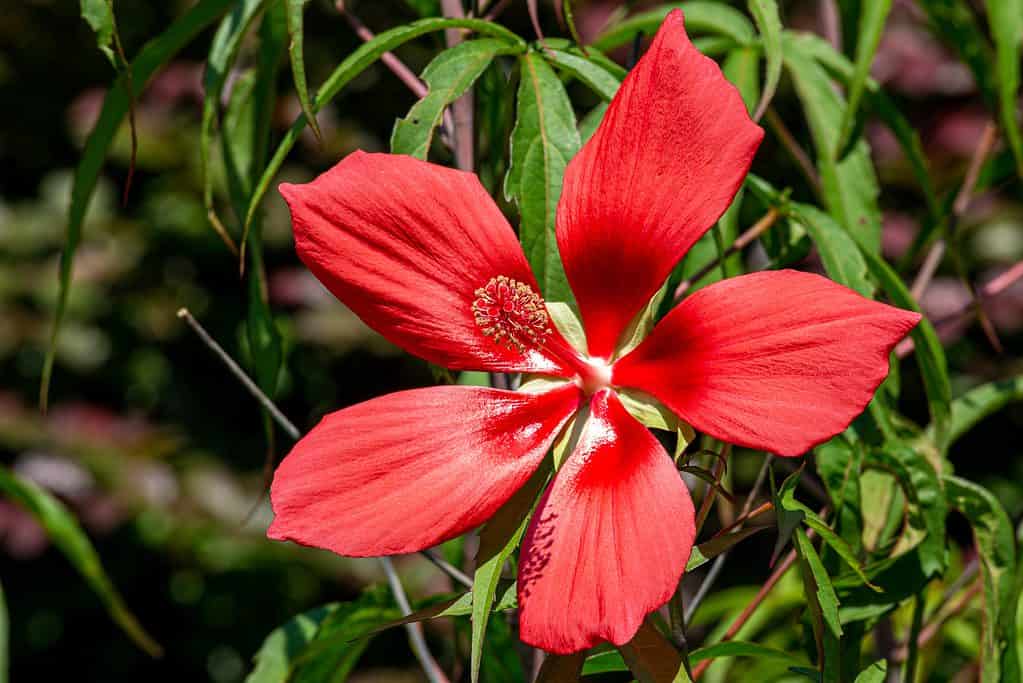
A perennial flower, the scarlet rose mallow measures 3-5 inches in diameter.
©billysfam/Shutterstock.com
The scarlet rose mallow is a perennial with a woody base known for its red, five-petal flowers that measure between 3 and 5 inches in diameter. These striking blossoms appear from the middle of summer until early fall and feature a prominent cluster of pale yellow or creamy-white stamens at their center. Even when it’s not in bloom, this plant still adds beauty to any garden thanks to its glossy, deeply green leaves.
It does well in either full sun or partial shade and prefers soil that is moderately moist but can also handle wetter conditions. Additionally, it holds up well in hot, humid weather. Just be sure to place it in an area shielded from strong winds to avoid potential wind damage.
20. Carolina Redroot (Lachnanthes caroliana)
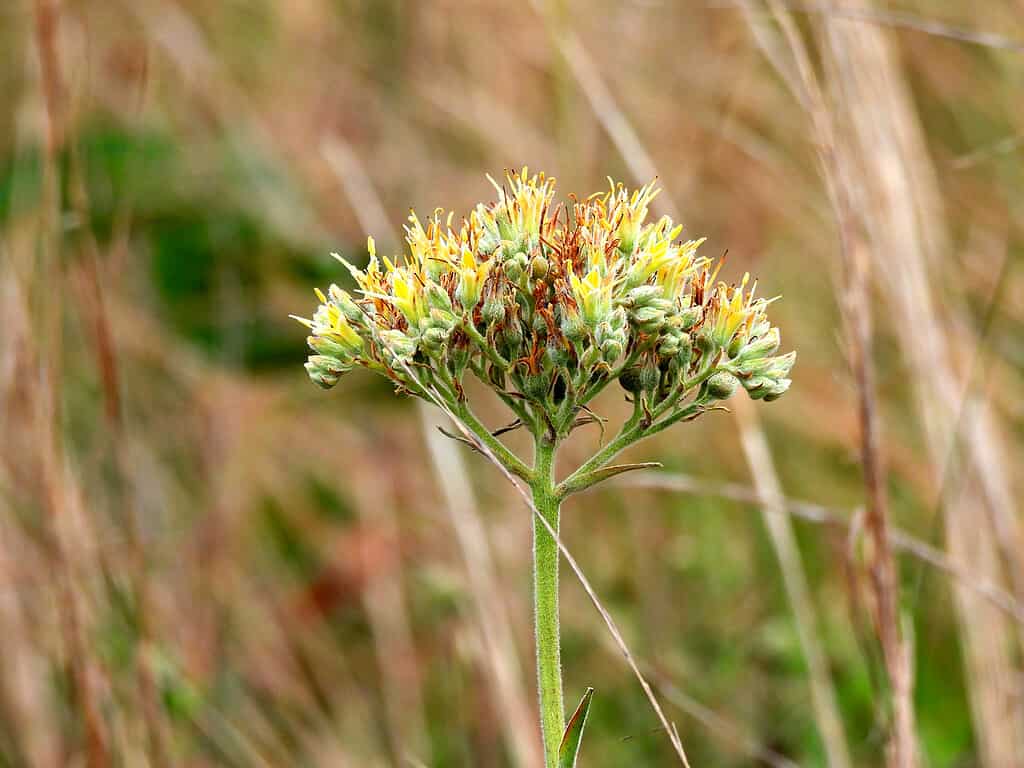
The final perennial flower that peaks in August on our list is the Carolina redroot.
©passion4nature/iStock via Getty Images
The Carolina redroot is a standout perennial plant known for its unique appearance. It produces bunches of small, fluffy-looking, creamy-yellow flowers measuring 2 to 4 inches across. These clusters create a fan-like shape and can be seen in both summer and fall. Originally from the eastern part of North America, this plant is most commonly found along the coasts stretching from Louisiana to Florida.
As for its growing conditions, it’s a fairly easy plant to care for. It prefers sunny to partially shaded spots and does best in wet or consistently moist soil on the acidic side.
Summary of Late-Blooming Perennial Flowers That Peak in August
| Number | Flower | USDA Hardiness Zone |
|---|---|---|
| 1. | Sunset Hyssop | 5-10 |
| 2. | Texas Hummingbird Mint | 5-9 |
| 3. | Climbing Aster | 7-10 |
| 4. | American Angelica | 4-7 |
| 5. | Golden Columbine | 3-8 |
| 6. | Apache Beggarticks | 10-11 |
| 7. | Bay Bean | 9-11 |
| 8. | Pink Turtlehead | 3-8 |
| 9. | Queen Cup | 4-8 |
| 10. | Slender Dayflower | 7-11 |
| 11. | Blue Mistflower | 5-10 |
| 12. | Rock Harlequin | 2-6 |
| 13. | Yellow Coneflower | 3-9 |
| 14. | Sulphur Buckwheat | 4-8 |
| 15. | Queen of Prairie | 3-9 |
| 16. | Indian Blanket | 2-11 |
| 17. | Great Vallery Gumweed | 7-10 |
| 18. | Maximilian Sunflower | 3-9 |
| 19. | Scarlet Rose Mallow | 6-9 |
| 20. | Carolina Redroot | 6-10 |
The photo featured at the top of this post is © Sundry Photography/iStock via Getty Images
Thank you for reading! Have some feedback for us? Contact the AZ Animals editorial team.







